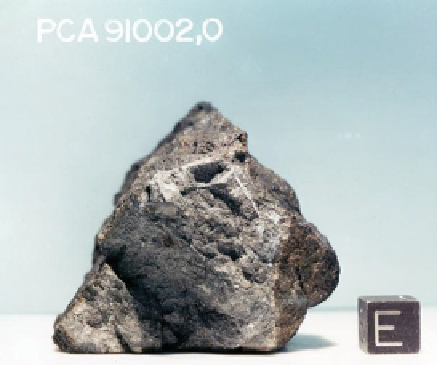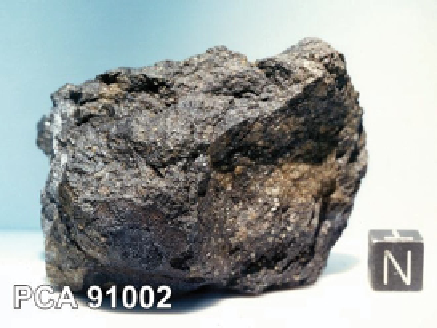Geology Reference
In-Depth Information
R3.8-6 chondrite
210.16 g
Found December 23, 1991
7.8 × 4.9 × 4.7 cm
Weathering = A/B
ordinary chondrites, such as chondrule types, rare refractory inclusions,
and similar chemical compositions. There are, however, significant differ-
ences between R chondrites and ordinary chondrites, such as a much
higher proportion of matrix, more oxidized (high Ni-olivine and com-
monly absence of metallic FeNi), and enrichments in
17
o over that of
ordinary chondrites. Many R chondrites are brecciated and may originate
in an asteroid regolith.
6.0
Rum
Acf
5.5
ALH
CL
DaG
PCA
5.0
Y75
4.5
LL
4.0
L
3.5
H
3.0
TF line
2.5
3.5
4.0
4.5
5.0
5.5
6.0
δ
18
O (‰ relative to SMOW)
Plate 35
MiNERALogy
SigNiFiCANCE
PCA 91002 contains numerous polycrystalline silicate
clasts (up to 1.2 mm in diameter), few small chondrules
(up to 0.5 mm), and mineral grains in a finely granular
matrix with minute sulfides (pentlandite with minor troi-
lite) disseminated throughout. No nickel-iron metal was
seen. olivine compositions show a prominent peak
at Fa
39
. The pyroxene is almost entirely low-Ca: Wo
0.3-5
,
Fs
1-28
, and maskelynite is present in a few clasts.
PCA 91002 was one of the first R chondrites recognized,
and it helped to define the distinguishing properties of
the group. The oxygen isotopic values of the R chon-
drites fall well above the terrestrial fractionation and
ordinary chondrite line (right, [234]), suggesting a larger
role for water in their source materials. R chondrites also
exhibit a diverse mineralogy, including metal, graphite,
and magnetite (not always together) recording a wide
range of oxygen fugacities within the group.
References [233-239]




























